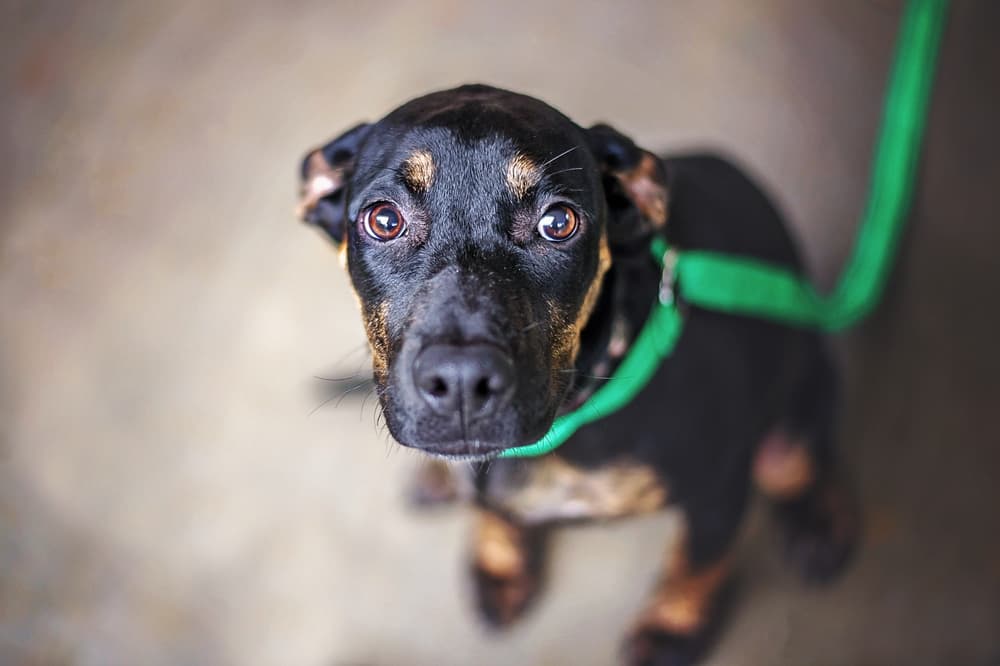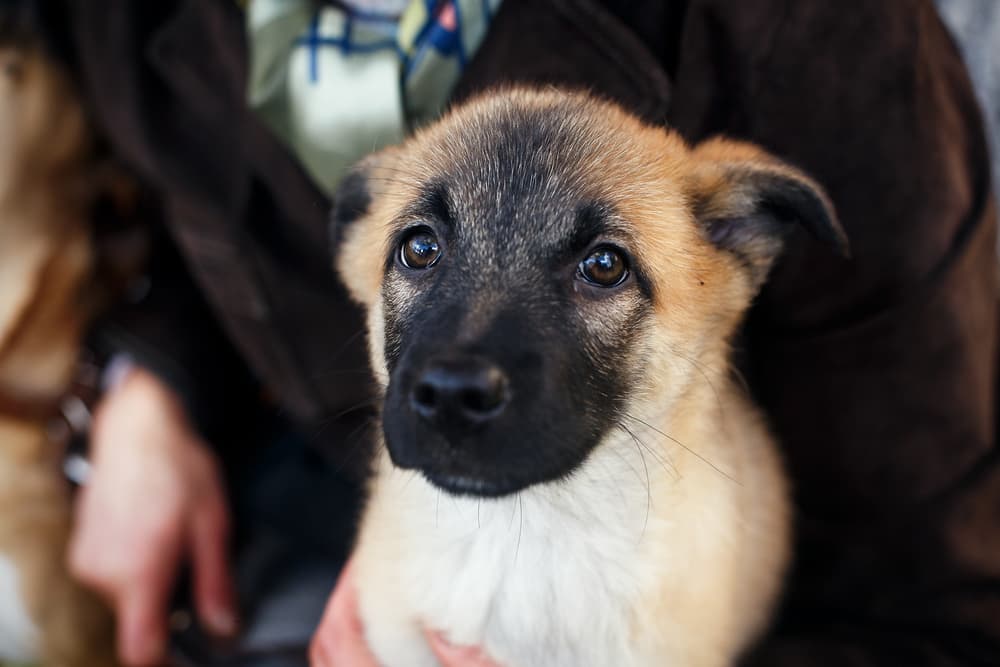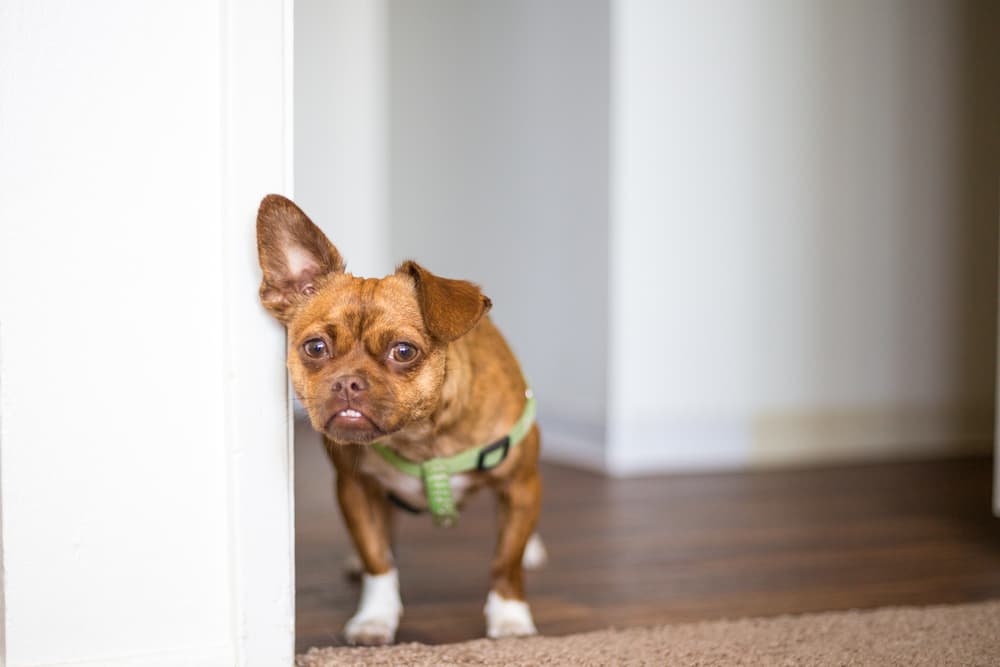Can Dogs Have Panic Attacks?

We’ve all experienced panic—feeling a knot in our stomach and racing heart when we forget an assignment or miss a meeting. Approximately 3 percent of U.S. adults and 2 percent of U.S. adolescents suffer from panic disorder and have panic attacks (1). These attacks are far more intense than run-of-the-mill nervousness or anxiety and typically occur out of the blue without any apparent cause.
Dogs also experience panic attacks. Although some dogs may develop a panic disorder, most canine anxiety attacks are associated with particular trigger situations.
What is a Panic Attack?
Humans suffering from a panic attack may feel sudden and intense fear or anxiety in addition to physical symptoms such as a racing heart, sweating, nausea, chest pain, shortness of breath, chills or heat sensations and dizziness.
Panic attacks may be associated with particular triggers or stressors or come on unexpectedly for no obvious reason. People diagnosed with depression, other anxiety or psychiatric disorders or who have experienced major stressors or life changes may be more prone to having panic attacks (2).
Can Dogs Have Panic Attacks?

Dogs also appear to experience panic attacks. Although dogs cannot tell us what they are feeling, we can extrapolate by observing their body language and behavior. Dogs suffering from a panic attack show signs indicative of fear and anxiety and physiologic changes associated with the flight-or-fight response.
It may be difficult to differentiate between a fearful or anxious dog and one that is having a panic attack.
Fear may be an understandable and adaptive response to a perceived threat. For example, a dog that trembles, growls and refuses to stand still when his nails are trimmed may be considered fearful in that situation.
But, a panic attack involves a much more severe, disruptive and disproportionate reaction. For instance, if we use the example above, a dog that cowers, screams, urinates and runs out of the room as soon as he sees the nail clippers may be experiencing a panic attack.
Causes of Panic Attacks in Dogs
For most dogs, panic attacks are a clinical sign of a larger behavioral problem. Any experience that causes a dog to be fearful or anxious can trigger a panic attack.
Trigger situations vary from dog-to-dog but common causes of panic attacks in susceptible dogs include:
- Being left alone or separated from people in dogs diagnosed with separation anxiety.
- Hearing specific sounds (e.g. fireworks, thunder, alarms) in dogs diagnosed with noise aversion or noise phobia.
- Exposure to a specific situation or environment (e.g. car rides, veterinary clinic) in dogs diagnosed with situational anxiety.
Some dogs may appear to experience panic attacks out of the blue and unrelated to a specific situation. In some cases, we are unable to detect the trigger that causes the dog to panic. Because dogs perceive the world differently and have a much more acute sense of hearing and smell compared to humans, we may not recognize the trigger that the dog is responding to—for example an ultrasonic noise or the scent of another animal.
Alternatively, some extremely anxious dogs are in a constant state of vigilance and distress. For these dogs with generalized anxiety, even mild stressors easily trigger a panic attack. Furthermore, dogs with generalized anxiety may react to many different triggers and not just one making it seem as though panic attacks occur for no particular reason.
Just as people often mistake a panic attack for a heart attack or vice versa, medical conditions in dogs may look similar to panic attacks. For instance, an irregular heart rhythm or sudden spike in blood pressure may cause dogs to show signs of fear or agitation, pant, or feel dizzy or weak. Before a seizure occurs, dogs may become nervous or restless, seek out attention or try to hide.
If your dog appears to have a panic attack, have your dog examined by a veterinarian to determine if there is a physical cause for this change in behavior.
Signs of a Dog Panic Attack

Dogs experiencing panic attacks show both behavioral and physical signs of fear and anxiety including:
- Pacing
- Hiding
- Escape behavior
- Pinned-back ears
- Tucked tails
- Trembling
- Barking or whining
- Dilated pupils
Similar to people, dogs experiencing a panic attack may also have an elevated heart rate and may sweat, leaving wet paw prints on the ground. If their fear is severe enough, some dogs may experience stomach upset and they may vomit or have an accident in the house.
What to Do If Your Dog is Having a Panic Attack
If you believe your dog is having a panic attack, there are a few steps you can take to help calm your dog down. Try the following tips to help your dog recover and relax.
Stay calm. Take a deep breath. Remaining calm and collected is the best thing you can do for your dog. Your fear, frustration or anger may make your dog more anxious.
Remove your dog from the situation. Whenever possible, identify the cause of your dog’s panic attack and end it or remove your dog from the situation. For example, if your dog has separation anxiety, return home. Dogs that panic at the vet office should have their appointment rescheduled for a later date. This is NOT a “failure” for you or your dog. Instead, think of these experiences as trial runs. Regroup and formulate a plan for the next time.
Give your dog space and time to calm down. Some dogs need a long time to calm down. Move your dog to a safe location where he cannot injure himself or others. A quiet, dark room may help. Dogs with firework or thunderstorm phobias may do best in an insulated room such as a walk-in closet where the noise is muffled.
While some dogs prefer to be alone, other dogs may enjoy being massaged, talked to in a soothing voice or even taken on a walk. If your dog is calm enough to focus on another activity, engaging him in play or practicing some fun, easy training exercises for yummy treats may distract him and keep his mind occupied.
Try anti-anxiety products and medications. For milder panic attacks, playing calming background music, using pheromone sprays or diffusers, and offering over-the-counter anti-anxiety supplements may help decrease both the intensity and the duration of the episodes.
Consult with your veterinarian regarding which products are safe and effective. Similar to people who suffer from panic attacks, fast-acting pharmaceutical medication may be best if your dog’s panic attacks are severe or frequent. These medications can only be prescribed by your vet.
What to Do Following a Dog Panic Attack
After the panic attack is over maintain a journal of your dog’s panic attacks, noting the date and time, situation that triggered the attack (if known), the duration and the relative intensity of the attack (mild, moderate, severe).
These notes will help you and your veterinarian determine the best course of action, including whether anti-anxiety medication or professional help are needed. Recording every panic attack that occurs helps verify if your dog’s anxiety is improving over time.
How to Prevent Dog Panic Attacks

Understanding what is causing your dog’s panic attacks and fear responses can help you predict when they may happen and step in before your dog starts to panic.
Use your journal to determine situations that may trigger your dog’s panic attacks so you can avoid them. For example, if your dog suffers from separation anxiety, enrolling your dog in daycare or having a dog walker take him on a hike may reduce the amount of time he spends alone. If your dog panics during thunderstorms, keep an eye on the weather forecast so you know when it’s going to rain.
Catch early signs of fear and redirect your dog’s focus. Your dog may show subtle signs of fear or anxiety, such as whining, pacing, panting or hypervigilance before panic fully sets in. When you first notice signs of fear, immediately remove your dog from the situation and engage him in an activity he enjoys such as going on a walk, playing, going on a car ride, or getting treats.
It is never too early to consult with your vet or a positive-reinforcement trainer about your dog’s behavior. Your vet or trainer can work with you and your dog to implement a behavior modification plan to address the underlying cause of your dog’s panic attacks. This may include the use of anti-anxiety medications or supplements to prevent panic attacks or treat them if they occur.
The best way to prevent panic attacks is to make sure they don’t occur in the first place. As soon as you adopt a dog, begin pairing potentially scary situations such as being home alone, thunderstorms, fireworks, veterinary visits, nail trims, etc. with something your dog enjoys, such as an extra delicious treat, game of fetch or a new squeaker toy.
Think of these positive associations as “vaccinating” your dog against future panic attacks.
References Cited in This Article:
- National Institute of Mental Health. 2017. Panic disorder. https://www.nimh.nih.gov/health/statistics/panic-disorder.shtml. Accessed June 2020.
- Mayo Clinic. Panic attacks and panic disorder. https://www.mayoclinic.org/diseases-conditions/panic-attacks/symptoms-causes/syc-20376021#:~:text=A%20panic%20attack%20is%20a,heart%20attack%20or%20even%20dying. Accessed June 2020.









